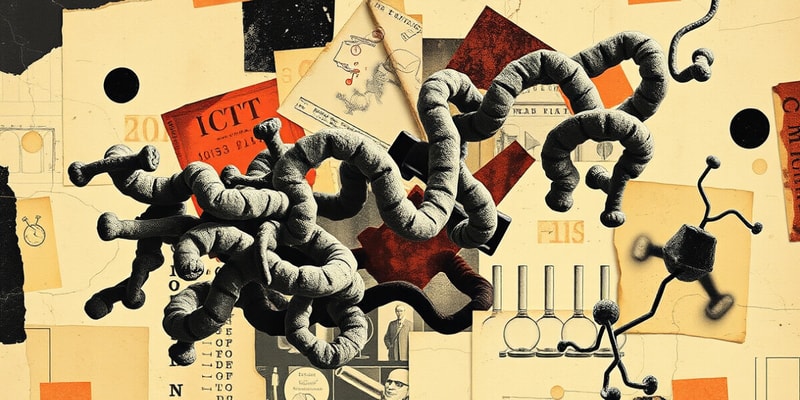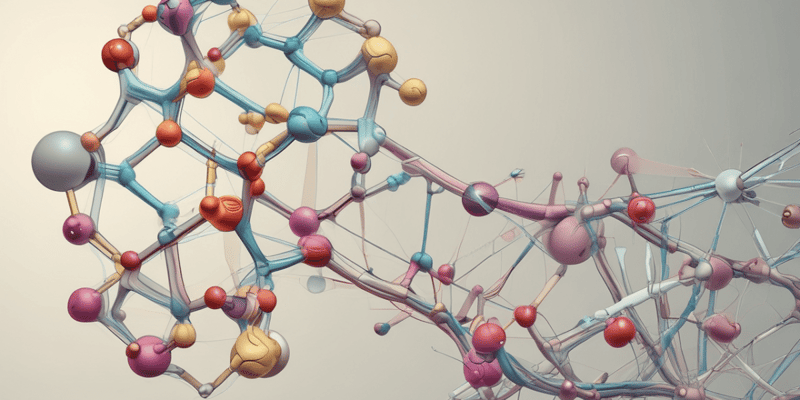Questions and Answers
What role do molecular chaperones play in protein function?
Which type of amino acid R-group is characterized as a proton donor?
What is formed between the carbon of the carboxyl group of one amino acid and the nitrogen of the amino group of another during peptide bond formation?
What is the primary determinant of the chemical properties of an amino acid?
Signup and view all the answers
What feature characterizes proteins as the most functionally diverse biomolecules?
Signup and view all the answers
Which amino acids would have a positively charged R-group?
Signup and view all the answers
What is the result of improper protein folding?
Signup and view all the answers
Which statement best describes a peptide bond?
Signup and view all the answers
What is the minimal required structure for a protein to perform its function?
Signup and view all the answers
Which amino acids must be obtained through dietary sources due to their essential nature?
Signup and view all the answers
What type of bond forms between the carboxyl group of one amino acid and the amino group of another during peptide bond formation?
Signup and view all the answers
How does the sequence of amino acids in a polypeptide influence its characteristics?
Signup and view all the answers
What is the primary distinction between a polypeptide and a protein?
Signup and view all the answers
Which statement regarding the interaction of R-groups in amino acids is accurate?
Signup and view all the answers
What type of bond primarily stabilizes the α-helix in secondary protein structure?
Signup and view all the answers
Which interaction is NOT involved in the stabilization of tertiary protein structure?
Signup and view all the answers
How do R-groups influence the shape of a protein at the tertiary level?
Signup and view all the answers
What characteristic is primarily associated with the β-pleated sheet in secondary protein structure?
Signup and view all the answers
What is the main influence of hydrophobic R-groups in protein tertiary structure?
Signup and view all the answers
Which level of protein structure is characterized by the unique three-dimensional shape of a polypeptide chain?
Signup and view all the answers
What type of bond forms between cysteine side chains and significantly impacts the protein's tertiary structure?
Signup and view all the answers
Which statement about secondary protein structure is TRUE?
Signup and view all the answers
What structural feature distinguishes unsaturated fatty acids from saturated fatty acids?
Signup and view all the answers
Which macromolecule class does cholesterol belong to?
Signup and view all the answers
What is the primary function of phospholipids in cellular structures?
Signup and view all the answers
Which of the following statements about lipids is correct?
Signup and view all the answers
What type of bond is responsible for the polymerization of triglycerides?
Signup and view all the answers
What type of bond is primarily responsible for the stabilization of secondary protein structures such as alpha-helices and beta-pleated sheets?
Signup and view all the answers
Which characteristic applies to saturated fatty acids?
Signup and view all the answers
Which of the following factors can lead to irreversible denaturation of protein structure?
Signup and view all the answers
Which term describes a molecule that has both hydrophobic and hydrophilic properties?
Signup and view all the answers
What constitutes the primary structure of a protein?
Signup and view all the answers
In which aspect do lipids differ fundamentally from carbohydrates?
Signup and view all the answers
How do changes in temperature affect protein structure?
Signup and view all the answers
What is the role of alpha helices and beta pleated sheets in proteins?
Signup and view all the answers
What distinguishes steroids from other types of lipids?
Signup and view all the answers
Which level of protein structure is formed by the interactions between R groups of amino acids?
Signup and view all the answers
What is a consequence of denaturation in proteins?
Signup and view all the answers
What type of interaction is primarily responsible for the formation of quaternary protein structures?
Signup and view all the answers
Which statement accurately describes a characteristic of tertiary protein structure?
Signup and view all the answers
What is the implication of changing pH on protein structure?
Signup and view all the answers
Which of the following best describes the influence of protein structure on its function?
Signup and view all the answers
Study Notes
Overview of Protein Structure
- Proteins exhibit four levels of structure: primary, secondary, tertiary, and quaternary, each influencing size, shape, and chemical properties.
Primary Protein Structure
- The linear sequence of amino acids linked by peptide bonds.
- Peptide bonds form through dehydration synthesis, linking the carboxyl group of one amino acid to the amino group of another.
- The specific order of amino acids determines the protein’s unique characteristics.
Secondary Protein Structure
- Involves local folding of the polypeptide chain.
- α-helix: Formed by hydrogen bonds between the carbonyl oxygen and the amino hydrogen four residues down the chain.
- β-pleated sheet: Stabilized by hydrogen bonds between carbonyl oxygen and amino hydrogen, creating a pleated appearance.
- This structure influences the protein’s overall shape and stability.
Tertiary Protein Structure
- Represents the unique three-dimensional arrangement of a single polypeptide chain.
- Determined by interactions among R-groups of amino acids, including:
- Electrostatic repulsion between like-charged R-groups.
- Hydrophobic R-groups cluster in the protein's interior to avoid water.
- Disulfide bridges formed between cysteine side chains, stabilizing the structure.
- Tertiary structure affects the protein’s functionality and specificity.
Quaternary Protein Structure
- Involves the assembly of multiple polypeptide chains into a single functional unit.
- Each polypeptide subunit can have its own tertiary structure.
- The interactions between subunits can include hydrogen bonds, ionic bonds, and hydrophobic interactions.
Denaturation of Proteins
- Denaturation refers to the alteration of a protein's structure, leading to loss of function.
- Changes can occur due to:
- Extreme temperature variations (e.g., heating).
- Alterations in pH levels.
- Denaturation is often irreversible and can transform proteins from liquid to solid states, as seen with cooking egg proteins.
Amino Acids and Chemical Properties
- Amino acids are characterized by a central α-carbon attached to an amino group, carboxyl group, hydrogen atom, and distinctive R-group.
- R-groups dictate the properties of amino acids as acidic, basic, polar, or nonpolar.
- Essential amino acids must be obtained from the diet, while non-essential ones can be synthesized by the body.
Peptide Bond Formation
- Peptide bonds form between amino acids during protein synthesis, releasing water in the process.
- The continuous chain of amino acids creates a polypeptide, which may fold into a functional protein.
Differentiating Polypeptides and Proteins
- Polypeptide: A chain of amino acids linked via peptide bonds.
- Protein: May consist of one or multiple polypeptides, often combined with non-peptide components and exhibits distinct structural and functional properties.
Importance of Protein Structure on Function
- Accurate protein folding is crucial for functionality; misfolding can result in diseases.
- Molecular chaperones assist in proper folding and maintenance of protein structures.
Studying That Suits You
Use AI to generate personalized quizzes and flashcards to suit your learning preferences.
Description
This quiz covers the four levels of protein structure, focusing on secondary protein structure, including the formation of α-helices and β-pleated sheets. It examines the bonds involved in these structures and their impact on the protein's size, shape, and chemical properties. Test your understanding of protein folding and its significance in biochemistry.




